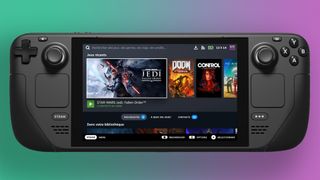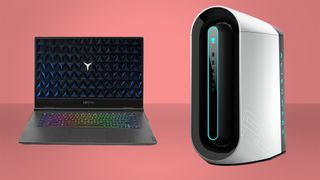Steam Deck: what sort of gaming performance can we expect from Valve's handheld PC?
The Steam Deck is powered by some of the latest AMD architectures, but what does that actually mean in terms of gaming performance?

It's been less than 24 hours since Valve announced the Steam Deck, but what a busy period it has been. The PC gaming handheld has made quite a splash online and has already worked its magic on some members of the team as they look to ditch their Nintendo Switch. But the first question on my mind when I heard Valve's portable plan was in regards to tech specs: What is going on under the hood to make this happen? So with that in mind, let's dive into the Steam Deck's silicon heart to see what's going on and how it might compare to today's components.
What powers the Steam Deck hasn't been ripped directly out of Gabe Newell's imagination. Instead, it's built by a company that's, say, a little well-known in the gaming industry today: AMD.
The AMD processor explained
The Steam Deck APU (AMD's term for a CPU/GPU combo) uses AMD's Zen 2 CPU architecture and RDNA 2 GPU architecture. What this means is that the processor component is similar to AMD Ryzen 3000-series processors on desktop (introduced in 2019), while the GPU component is a match for the Radeon RX 6000-series graphics architecture (introduced in 2020).
We do have to be a little careful with such comparisons, however. There are no chips which are the exact mirror-image of the APU found in the Steam Deck today. Desktop counterparts, such as the Radeon RX 6700 XT graphics card, have many more cores inside them than the Steam Deck can offer. Similarly, the Xbox Series X/S and PS5 utilise the exact same CPU and GPU architecture, although once again are far from a match numbers-wise.
There's no direct apples to apples comparison here.

The Steam Deck features a four-core/eight-thread Zen 2 CPU. That's roughly equivalent to the Ryzen 3 3100 CPU (a $99 budget desktop CPU), although the Steam Deck CPU runs a touch slower at 2.4-3.5GHz. That's likely a move to keep this chip within a fairly restrictive power envelope, thus extending battery life and minimising thermal demand—the whole AMD APU in the Steam Deck requires just 4-15W of power.
Then there's the GPU component; the main driver for the gaming experience on the handheld. This is formed by eight RDNA 2 Compute Units (CUs), making for 512 cores in total. The RDNA 2 architecture means each of these CUs will be accompanied by an RT Core, which will nominally allow for ray tracing acceleration. However, such a slim number really won't make for a great experience in any ray-traced game.
The biggest gaming news, reviews and hardware deals
Keep up to date with the most important stories and the best deals, as picked by the PC Gamer team.
This RDNA 2 GPU will run at 1–1.6GHz and deliver up to 1.6 TFlops FP32 performance. That is a general marker of this chip's compute performance, but again isn't entirely comparable with older or competing GPU generations. It's more of a guideline, let's say. To get a better sense of how the Steam Deck will perform, we have to look at the other specs, too.
The full Steam Deck specs
To get a more complete idea of how the Steam Deck will perform, we need to look at what else is inside of it, especially the fancy new LPDDR5 memory, the subject of the next section.
| Header Cell - Column 0 | Steam Deck |
|---|---|
| CPU | AMD Zen 2 |
| Core count | 4-core/8-thread |
| CPU clock speed | 2.4–3.5GHz |
| GPU | AMD RDNA 2 |
| GPU Compute Units | 8 |
| GPU clock speed | 1–1.6GHz |
| RAM | 16GB LPDDR5 @ 5,500MT/s |
| Storage | 64GB eMMC / 256GB NVMe SSD / 512GB NVMe SSD |
| Display | 7-inch LCD touchscreen |
| Resolution | 1280 x 800 |
| Refresh rate | 60Hz |
| Audio | Stereo speakers, 3.5mm jack, dual mics, USB Type-C/Bluetooth |
| Connectivity | Wi-Fi, Bluetooth, USB Type-C with DisplayPort 1.4 support |
| Battery | 40Whr |
| Size | 11.7 x 4.6 x 1.8-inch (298 x 117 x 49mm) |
| Weight | Approximately 1.47 lbs (669 grams) |
| Price | $399 (64GB) / $529 (256GB) / $649 (512GB) |
The LPDDR5 RAM explained
Connecting all the silicon together is 16GB of LPDDR5 RAM at 5,500MT/s. This new memory standard is quick, and outpaces most DDR4 memory found in modern gaming PCs. While DDR5 will offer an even greater leap in performance, the lower-power mobile LPDDR5 memory still offers tremendous speeds.
Valve is offering a happy blend of speed and capacity in the Steam Deck, but that LPDDR5 memory is a bit of a wildcard. It's fast and there's plenty of it, but it's also going to be divided between CPU and GPU and cannot offer the bandwidth that graphics-specific GDDR6 memory can, which you'd find on any modern discrete graphics card in laptop or desktop. Or, perhaps more importantly, in any console running a similar APU.

Steam Deck performance: the realistic expectations
With the general specifications in hand, we can at least begin to extrapolate rough performance figures for Valve's new device—bearing in mind everything I just said about this not being a perfect science.
In terms of TFlops, the RDNA 2 chip within the Steam Deck is a match for Intel's 96 EU Xe graphics, which is most commonly found within Intel Tiger Lake mobile processors. Intel's GPU offers between 1.7 and 2.1 TFlops of FP32 performance, so a touch higher than the RDNA 2 chip in the Steam Deck, but it's worth mentioning that the RDNA 2 architecture is built first and foremost for gaming and has shown itself plenty capable of more than making up for raw compute power when it comes to frame rates.
If you're happy to run your games on low to medium settings at 720p to hit 30-60 fps, then the Deck should deliver.
Lucky for us, we've not only tested Intel Tiger Lake's 96 EU iGPU, our own Alan Dexter has taken said GPU for a spin in another PC gaming handheld, the One-netbook Onexplayer.
The Onexplayer also comes with a four-core CPU with up to eight threads, 16GB of slower DDR4 RAM, and that 96 EU Intel Xe GPU. So it's as good a match-up as we're going to get.
The Onexplayer manages to offer 35 fps in Shadow of the Tomb Raider at 720p and with low graphics settings. In GTA V, that increases up to 60 fps, which isn't too bad at all. Alan reports further success in games such as Dirt Rally, Forza Horizon 4, and low-impact games such as Hearthstone or Magic The Gathering: Arena.
Cyberpunk 2077 was, of course, out of the question.
One issue Alan notes in his Onexplayer review might also be something we encounter with the Steam Deck, and that's getting games to run at the native 1280 x 800 resolution, or 16:10 aspect ratio. It's far more likely for games to support a 16:9 720p resolution, and you may find games run that little bit better at that size, too.
Conclusion

Best gaming PC: the top pre-built machines from the pros
Best gaming laptop: perfect notebooks for mobile gaming
More nebulous concepts of performance would say this is roughly equivalent to the PS4 or Xbox One, although that's a slightly more difficult comparison as console games don't often offer frame rate counters and the like. In terms of raw CU count, the Steam Deck is just under half the specification of the Xbox Series S, although, again, there are all sorts of memory and other architectural changes you'd need to consider to say anything of value there.
To know anything for sure, we'll have to get a Steam Deck to benchmark for ourselves (we're working on it). A specs list just can't give us the whole picture, but we can say a few things pretty confidently. Is the Steam Deck going to crush in the latest games? No. Is it going to drive the Valve Index in VR? No. Is it potentially a great way to play PC games in bed or on the train? Hell yeah, it looks like it.
The Steam Deck isn't quite the "powerhouse" Valve claims it to be, but if you're happy to run your games on low to medium settings at 720p to hit 30-60 fps, then it should get you happily playing PC games away from your desk—at least while the 40Whr battery lasts.

Jacob earned his first byline writing for his own tech blog. From there, he graduated to professionally breaking things as hardware writer at PCGamesN, and would go on to run the team as hardware editor. He joined PC Gamer's top staff as senior hardware editor before becoming managing editor of the hardware team, and you'll now find him reporting on the latest developments in the technology and gaming industries and testing the newest PC components.
Most Popular


